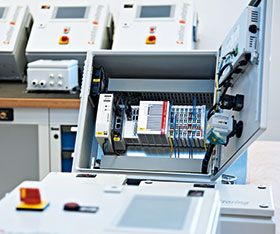

TAR Automation specialises in high-quality automation technology, supporting manufacturing companies through the integration of innovative control solutions.
In addition to the design and implementation of new systems, as well as modernisation of existing production machines, TAR develops system solutions in the areas of motion control and condition monitoring. The company recently developed an efficient condition monitoring system (CMS) for production equipment, based on integrated automation solutions from Beckhoff.
“In the early days of our enterprise, we used conventional PLC and scada products almost exclusively. Today, we increasingly employ PC-based automation solutions from Beckhoff,” explains Alfred Rachner, managing director of TAR Automation. “The multi-functional TwinCAT 3 automation platform provides an efficient development environment for our engineers to create software components. The scaled series of embedded PCs providing the ideal hardware platform for the performance requirements of any task at hand.”
Seamlessly integrated condition monitoring system
“The PC-based control solution enables us to integrate numerous new functions in automation technology, which in the past could only be realised using dedicated ‘black-box devices’. Condition monitoring for production equipment is a good example,” says Rachner. “A conventional condition monitoring system (CMS) is usually installed as a separate subsystem within the design. It consists of special hardware for data sampling and evaluation, has a fixed number of channels and a defined functionality. This makes such stand-alone solutions very inflexible: the user is unable to respond to changing needs, and condition monitoring functions become difficult to integrate, as well as very expensive.”
Enhanced flexibility and reduced costs drove the TAR engineering team to develop the TAR 9964 condition monitoring system, which is based on a CX5140 Embedded PC with TwinCAT 3 software, the TwinCAT Condition Monitoring library and EtherCAT Terminals as the control platform. EL3632 Condition Monitoring terminals are used to connect IEPE acceleration sensors.
Process optimisation of a granulator
The TAR 9964 CMS provides, as a real-world example, monitoring and process optimisation of a shredding machine for recyclable material such as components used in PCBs, cooling units, washing machines, various plastics or tyres. The granulator has a 400 kW drive for the cutter shaft and a 12 kW hydraulic unit for the pushing unit and stator adjustment. The cutter shaft features acceleration sensors, whose data are logged via the EL3632. First, software function blocks from the TwinCAT Condition Monitoring library acquire and bundle data in a very fast task. In one or several subsequent tasks, various analysis function blocks are used for additional operations, such as Fourier analysis, limit value monitoring, averaging and classification. The library also ensures correct time correlation of the acquisition and analysis tasks.
The integrated condition monitoring system results in tangible benefits for the operator of the shredding system:
• Bearing monitoring: In the past, bearings were monitored via temperature measurement, so that impending bearing damage was usually detected too late.
• Vibration, limit value and trend analysis: Detect potential bearing damage before costly damage actually occurs.
• Over-lubrication detection: Minimise lubrication waste.
• Optimised system operation: If the working area is not closed properly, the material ‘dances’ on the cutter shaft and does not shred correctly. The resulting increased vibrations can now be measured, and the feed corrected by applying pressure.
• Automatic V-belt tension detection: Automatic detection and adjustment of loose V-belts Detection of blunt cutters: In the past, the plant was inspected “by ear”, requiring personnel to actually listen for changes in equipment and the cutters were sharpened manually when needed. The condition monitoring system supplies reliable measurement readings for detecting blunt cutters and sharpening is carried out automatically.
• Integration into the machine control system: Historically, the material feed was controlled manually. Previous attempts to control the infeed with optical measuring systems were unsuccessful, because the materials to be shredded differ greatly in size and form. Now, the vibration analysis function of the condition monitoring system enables reliable detection when the granulator is empty, supplying new material automatically. Continuous utilisation of the machine increases productivity by up to 50 percent.
New potential for system integrators
“For TAR, integrating condition monitoring into the automation and control system also opens up new opportunities and sales potential,” points out Rachner. “TwinCAT is ideal for us as an integration platform: From simple control tasks to motion control, CNC applications, condition monitoring and safety technology, we can solve any task with a single system. This eliminates costs for training programmers on different platforms, and we only have to install and maintain a single engineering system in our departments. The same savings apply to maintenance procedures at our customers’ sites.

“In addition, TwinCAT supports all common fieldbus interfaces such as Profibus, Profinet, EtherNet/IP, and CANopen, so that we can easily integrate our solutions into the control environments our customers use – for example, when it comes to modernising an existing system.”
Industry 4.0: Communication standards for vertical and horizontal networking
The wide range of Embedded PCs are scalable in terms of performance and I/O configuration while offering diverse networking options. This offers many degrees of freedom when implementing control architectures and, as a result, optimum solutions for the tasks at hand. “Whether we are dealing with a small, stand-alone solution, networking of decentralised, intelligent controllers or a high performance central solution – anything is possible,” concludes Rachner. “In combination with support for OPC UA as the universal standard for vertical networking, it is also possible to integrate ERP systems, both within a site and across sites.”
For more information contact Kenneth McPherson, Beckhoff Automation, +27 (0)11 795 2898, [email protected], www.beckhoff.co.za
| Tel: | +27 11 795 2898 |
| Fax: | 086 603 6868 |
| Email: | [email protected] |
| www: | www.beckhoff.com |
| Articles: | More information and articles about Beckhoff Automation |
© Technews Publishing (Pty) Ltd | All Rights Reserved